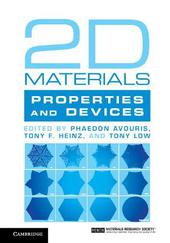
|
2D Materials: Properties and Devices
Hardback
Main Details
| Title |
2D Materials: Properties and Devices
|
| Authors and Contributors |
Edited by Phaedon Avouris
|
|
Edited by Tony F. Heinz
|
|
Edited by Tony Low
|
| Physical Properties |
| Format:Hardback | | Pages:523 | | Dimensions(mm): Height 253,Width 178 |
|
| Category/Genre | Materials science
Electronics engineering |
|---|
| ISBN/Barcode |
9781107163713
|
| Classifications | Dewey:620.115 |
|---|
| Audience | | Professional & Vocational | |
|---|
| Illustrations |
12 Tables, black and white; 71 Halftones, black and white; 161 Line drawings, black and white
|
|
Publishing Details |
| Publisher |
Cambridge University Press
|
| Imprint |
Cambridge University Press
|
| Publication Date |
29 June 2017 |
| Publication Country |
United Kingdom
|
Description
Learn about the most recent advances in 2D materials with this comprehensive and accessible text. Providing all the necessary materials science and physics background, leading experts discuss the fundamental properties of a wide range of 2D materials, and their potential applications in electronic, optoelectronic and photonic devices. Several important classes of materials are covered, from more established ones such as graphene, hexagonal boron nitride, and transition metal dichalcogenides, to new and emerging materials such as black phosphorus, silicene, and germanene. Readers will gain an in-depth understanding of the electronic structure and optical, thermal, mechanical, vibrational, spin and plasmonic properties of each material, as well as the different techniques that can be used for their synthesis. Presenting a unified perspective on 2D materials, this is an excellent resource for graduate students, researchers and practitioners working in nanotechnology, nanoelectronics, nanophotonics, condensed matter physics, and chemistry.
Author Biography
Phaedon Avouris is an IBM Fellow Emeritus. He is a member of the National Academy of Sciences, and a Fellow of the American Academy of Arts and Sciences, the American Physical Society, the Institute of Physics, the Institute of Electrical and Electronics Engineers (IEEE), the Materials Research Society, and the American Association for the Advancement of Science. Tony F. Heinz is a Professor of Applied Physics and Photon Science at Stanford University, California and the SLAC National Accelerator Laboratory. He previously worked at Columbia University, New York and IBM Research, USA. Tony Low is Assistant Professor of Electrical and Computer Engineering at the University of Minnesota. He previously worked at Yale University, Connecticut, Columbia University, New York, and the IBM T. J. Watson Research Center, New York.
Reviews'This book, edited by the top researchers who have been working on atomically thin materials in the past decade, contains the essential contents of our current scientific understanding of this novel form of materials. The authors have compiled comprehensive and contemporary reviews on various topics ranging from fundamental science to engineering applications, providing an excellent textbook for students as well as references for experts in the research field.' Philip Kim, Harvard University, Massachusetts 'This edited volume consists of 25 topical chapters contributed by scientists active in the growing field of 2D semiconductors, who summarize the most salient features of these intriguing materials. Contributions are grouped into three parts dedicated to graphene, transition metal dichalcogenides, and elemental group V layered semiconductors including phosphorene. Covered are the most actively researched topics synthesis, stability, thermal, and electronic properties including transport, optics, optoelectronics and spintronics, phonon structure, and mechanical properties of few-layer systems including heterostructures, as probed by state-of-the-art experimental and theoretical techniques. While emphasis is placed on the rigorous scientific representation of knowledge acquired to date, the contributors also offer a refreshing insight into potential applications of this new class of materials.' David Tomanek, Michigan State University 'The field of 2D materials, which started with graphene, now includes dozens of one-atom thick crystals. Many of them demonstrate properties end effects which are equally exciting as those found for the famous ancestor. And, judging from the recent progress, the field will be developing very fast for many years ahead. This book, written by scientists who are the leaders in their fields, is the most comprehensive and up-to-date attempt to review this fast-developing subject. Starting with an in-depth summary on graphene, it moves to other 2D crystals, such as transition metal dichalcogenides, black phosphorous and others, providing probably the most complete reference on the topic at the moment.' Kostya Novoselov, University of Manchester
|